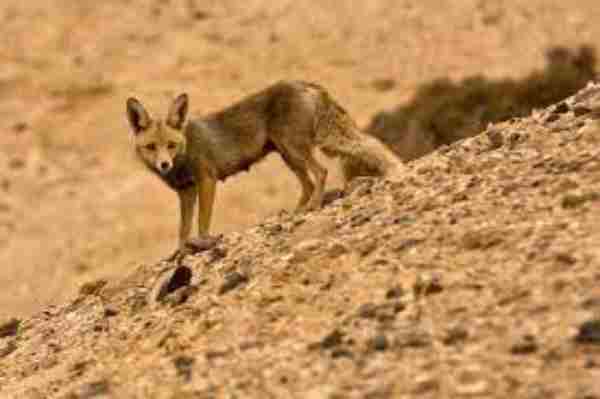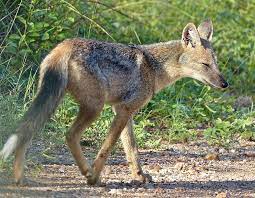Animals Similar to the Coyote: Kin of the Canid” delves into the captivating world of canines closely related to the iconic coyote. With an intriguing blend of biology, behavior, and ecological significance, this article embarks on a journey to uncover the lesser-known members of the canid family that share remarkable resemblances and evolutionary ties with the coyote.
Table of Contents
From the cunning foxes that traverse diverse landscapes to the enigmatic jackals with their distinctive vocalizations, this exploration sheds light on the intricate web of relationships within the canid lineage. Join us as we unveil the captivating stories of these kin to gain a deeper appreciation for their roles in the natural tapestry.
Animals Similar to the Coyote
Gray Wolf
Red Fox
Golden Jackal
Side-Striped Jackal
Dhole (Asian Wild Dog)
Raccoon Dog
Introduction to the coyote and its characteristics
The coyote (Canis latrans) is a highly adaptable and resilient canid species native to North and Central America. Known for its distinctive yipping and howling calls, the coyote possesses a range of intriguing characteristics. With a body length averaging between 32 to 37 inches and a bushy tail, it weighs around 20 to 50 pounds. Its fur coloration varies, often including shades of gray, brown, and tan, providing effective camouflage in diverse habitats.
Coyotes display remarkable intelligence and resourcefulness, thriving in various environments from deserts to forests. They exhibit both carnivorous and omnivorous dietary habits, feeding on small mammals, birds, fruits, and vegetation. Their adaptability to urban areas further exemplifies their ability to coexist with humans. Understanding these features provides insights into the coyote’s ecological role and interactions within its ecosystem.
Significance of Studying Similar Animals:
Studying animals similar to the coyote holds immense ecological and evolutionary importance. Comparable species, often residing within the same ecosystems, offer insights into shared adaptations and competitive dynamics. These studies enhance our comprehension of ecosystem stability and resilience. By examining the behavioral, physiological, and ecological traits of such animals, scientists gain valuable data for conservation strategies and management of biodiversity.
Additionally, these investigations contribute to our understanding of animal intelligence, social structures, and communication methods, with potential applications in various fields, including animal behavior and robotics. Furthermore, studying similar animals aids in deciphering the impacts of human activities on wildlife and the environment, guiding sustainable practices and preserving delicate ecological balances.
Overview of Species Similar to the Coyote:
Several species share ecological niches and adaptive strategies similar to the coyote. One such species is the red fox (Vulpes vulpes), characterized by its reddish fur and widespread distribution.
The gray wolf (Canis lupus) is another close relative, displaying pack behavior and intricate social hierarchies. The raccoon dog (Nyctereutes procyonoides) of East Asia showcases comparable omnivorous tendencies and adaptability to urban settings.
The golden jackal (Canis aureus) inhabits regions of Europe, Asia, and Africa, embodying traits of resourcefulness akin to the coyote. These species collectively provide a comprehensive understanding of canid diversity and adaptation strategies across different geographical areas and environmental conditions.
Gray Wolf:

As one of the most iconic members of the Canidae family, the gray wolf commands attention in discussions about coyote kin. Renowned for their social structure, complex communication, and ecological significance, gray wolves epitomize apex predators. Their pack dynamics, hunting strategies, and wide distribution across diverse habitats make them essential subjects of study.
Exploring the similarities and differences between gray wolves and coyotes offers a glimpse into their shared ancestral lineage and divergent evolutionary paths. Unraveling the intricate balance between competition and cooperation within the Canidae family, this article highlights the profound role that gray wolves play in shaping ecosystems.
Red Fox:

The red fox, with its vibrant coat and adaptable behavior, stands out as a remarkable counterpart to the coyote. As urbanization spreads, these canids have demonstrated unparalleled resourcefulness, thriving in both rural and urban environments. Their ability to exploit diverse food sources and exhibit behavioral flexibility has facilitated their global success.
By examining the parallels between red foxes and coyotes, we gain insights into the varying strategies that enable these species to coexist with human activities. This article delves into the captivating world of red foxes, shedding light on their unique adaptations and the critical role they play in shaping our changing ecosystems.
Golden Jackal:

Spanning continents from Europe to Asia and Africa, the golden jackal intrigues researchers seeking to understand the breadth of coyote kin. With a distinctive vocal repertoire and adaptable behavior, these canids have carved a niche in a wide range of ecosystems.
Their ecological roles, from scavengers to predators, reveal the dynamic interactions that shape local environments. By delving into the evolutionary connection between golden jackals and coyotes, this article uncovers shared traits and divergent paths, offering a window into the intricate ways in which these species respond to diverse ecological pressures.
Side-Striped Jackal:

In the heart of Africa, the side-striped jackal roams, exhibiting behaviors and adaptations that evoke both familiarity and curiosity in the context of coyote kin. Often found near water sources, these canids display a unique dietary versatility that contributes to their success in various habitats.
By examining their behaviors, interactions, and ecological significance, we gain a deeper understanding of the broader canid family and the roles these animals play in maintaining ecosystem equilibrium. The article explores the relationship between side-striped jackals and coyotes, offering a glimpse into the shared ancestral origins that shape their present-day survival strategies.
Dhole (Asian Wild Dog):

Venturing into the realm of Asian ecosystems, the dhole, or Asian wild dog, emerges as a compelling example of cooperative hunting and social structure among the canids. With their pack dynamics and complex communication, dholes showcase an alternative approach to survival within the same family as coyotes.
Their interactions with other species and their impact on local biodiversity underscore their ecological importance. By delving into the world of dholes and comparing them to coyotes, this article unravels the threads of evolutionary divergence and convergence, revealing the fascinating tapestry woven by the canid family across different landscapes.
Raccoon Dog:

The raccoon dog, often mistaken for its distant raccoon relatives, presents an intriguing case within the Canidae family. Native to East Asia, these canids display behaviors that set them apart from traditional canines. Their adaptability to both terrestrial and aquatic environments, along with their distinctive appearance, makes them stand out among the coyote’s kin.
By examining the raccoon dog’s traits, behaviors, and ecological roles, we gain insight into the diversity of adaptations within the canid lineage. Exploring the relationship between raccoon dogs and coyotes sheds light on the broader evolutionary strategies that have enabled these animals to thrive in their respective niches.
Behavior and Adaptations:
Examining the behavior and adaptations of animals akin to the coyote opens a window into the remarkable range of survival strategies within the Canidae family. From pack dynamics and communication techniques to unique hunting behaviors, understanding these traits provides insight into the evolutionary pressures that have shaped each species.
Delving into the diverse adaptations allows us to appreciate the ingenious ways in which these animals have thrived in various environments, adapting to challenges and opportunities alike.
Urban Adaptations:
The urban adaptations of coyote kin, like the red fox and raccoon dog, illuminate their capacity to navigate human-altered landscapes. Exploring their habits in urban ecosystems unravels the flexible behaviors that enable them to scavenge, hunt, and reproduce within city confines.
This adaptation sheds light on the inherent resilience of these animals and their surprising ability to coexist alongside human activities, provoking discussions about human-wildlife interactions and potential strategies for harmonious urban biodiversity.
Role in Ecosystems:
From apex predators to scavengers, the roles of animals closely related to the coyote extend far beyond their individual existence. Their interactions with prey, competitors, and other species reverberate through ecosystems, influencing population dynamics and shaping the delicate balance of nature. Unraveling these intricate relationships deepens our understanding of the complex web of life, emphasizing the significance of preserving these species for the health and stability of entire ecosystems.
Conservation and Protection:
The conservation and protection of coyote kin species is pivotal for maintaining biodiversity. Recognizing the challenges they face, including habitat loss, human conflicts, and disease transmission, highlights the urgency of implementing effective conservation measures.
Studying these species not only aids in developing targeted strategies for their survival but also underscores the importance of preserving the habitats and ecological connections that sustain them.
Interdisciplinary Studies:
Exploration of animals related to the coyote demands an interdisciplinary approach that transcends biology alone. Collaboration between ecologists, sociologists, policymakers, and communities is essential for crafting holistic conservation plans that consider both ecological needs and societal perspectives.
By integrating various fields of study, we can develop comprehensive strategies that not only protect these species but also foster harmonious coexistence between humans and wildlife.
Final Words
In traversing the diverse landscape of animals similar to the coyote, we uncover the intricate threads that connect them within the rich tapestry of the Canidae family. Each species, from the adaptable red fox to the cooperative dhole, contributes a unique hue to this vibrant fabric.
These animals teach us valuable lessons about evolution, adaptation, and our shared responsibility in safeguarding the natural world. As we continue to unveil the stories of these coyote kin, we gain a deeper appreciation for the complex interplay between life forms and the urgent need to preserve the remarkable diversity that enriches our planet.
Reference:
- https://nhpbs.org/kn/vs/scilab6fa4hacarnivora2.asp
- https://www.pinterest.com/pin/114138171786064719/
- https://floofmania.com/coyotes-look-like/

Rahul M Suresh
Visiting the Zoo can be an exciting and educational experience for all involved. As a guide, I have the privilege of helping students and visitors alike to appreciate these animals in their natural habitat as well as introducing them to the various aspects of zoo life. I provide detailed information about the individual animals and their habitats, giving visitors an opportunity to understand each one more fully and appreciate them in a more intimate way.









